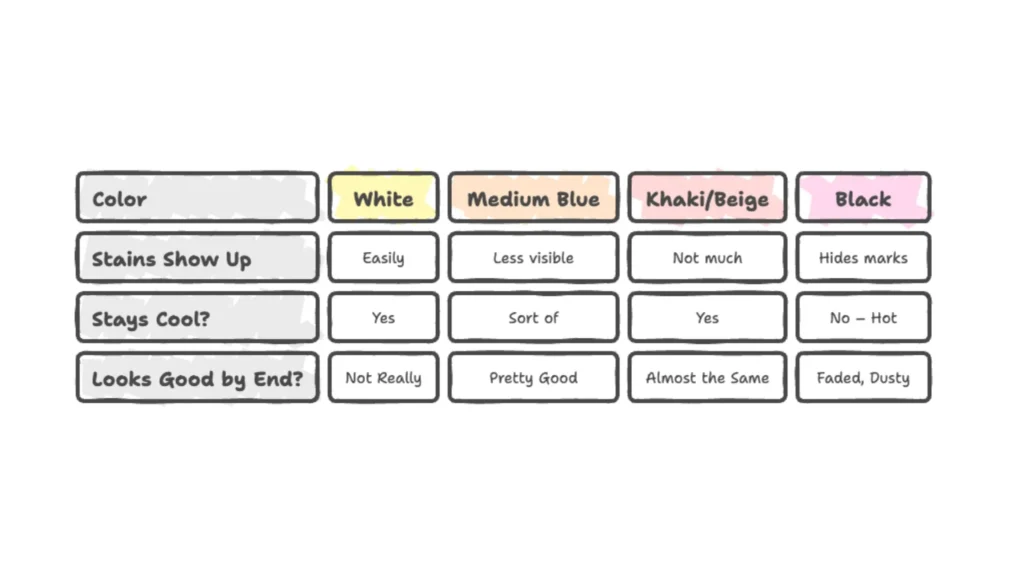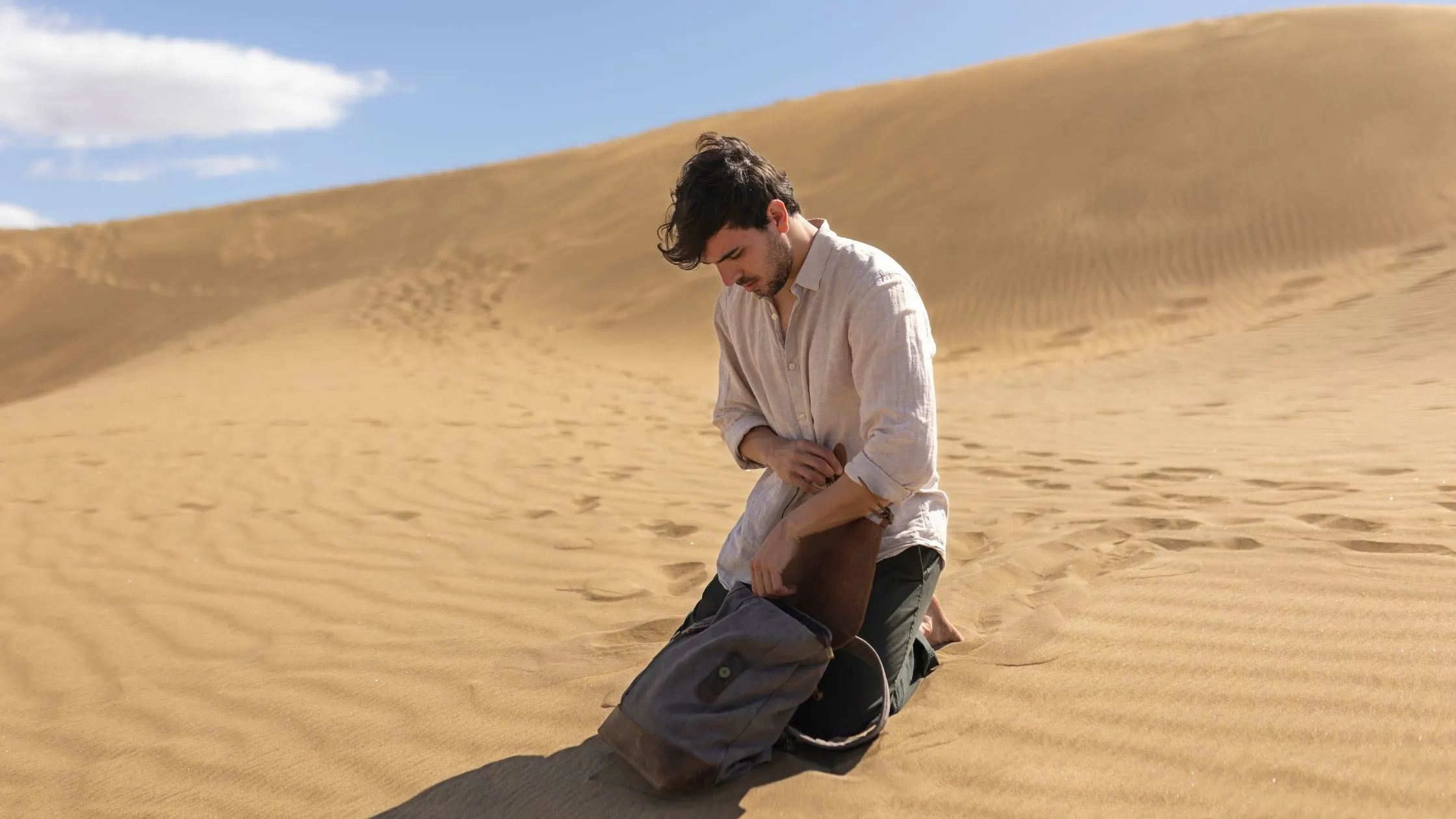Discover what not to carry in desert safari during your trip for a hassle-free desert adventure.
Table of Contents
Key Takeaways
- Leave formal and tight clothing at home; comfort and respect for local culture matter more.
- Skip heels, boots, and fancy shoes; stick with something you don’t mind getting sandy.
- Don’t pack heavy jackets; bring a light layer for cool nights instead.
- Avoid bringing jewelry, expensive gadgets, or too much cash—sand and valuables don’t mix.
- Cut down on makeup and toiletries; heat and sand will undo your efforts anyway.
As Mozin George, a licensed tour operator in Abu Dhabi with over 15 years of experience, I’ve personally guided thousands of travelers through the desert. I’ve seen people make the mistake of bringing the wrong clothes, heavy gadgets, and valuables—and regret it later. That’s why I want to share my real-life advice here, so your trip is smooth, safe, and truly enjoyable.
Leave Fancy Clothes and Tight Outfits at Home
Heading out for an Abu Dhabi desert safari can sound like the perfect time to wear your stylish favorites, but this is one trip where looking fancy isn’t going to do you any favors.Some guests are curious about what to wear during a desert safari. I’ve watched guests wear white suits, tight jeans, or designer dresses into the dunes—and by the end, they’re hot, dusty, and wishing they packed simpler clothes.Desert adventures call for relaxed, comfortable choices, not what you’d wear to a fancy dinner or club night.
Why Formal Wear Is a Big Mistake
Fancy clothes—think button-up shirts, cocktail dresses, or even that new sport coat—are the worst pick for a desert tour. Here’s why:
- You’ll get hot way too quickly. The desert sun has no chill.
- Sand gets everywhere, and it loves expensive fabrics.
- Sitting on rugs or hopping in and out of dune buggies is going to ruin that dry-clean look fast.
- Formal outfits just stand out awkwardly among relaxed, comfy travelers.
If you’re tempted to bring something sleek or flashy, just leave it in your hotel closet. You’ll thank yourself by the end of the day.
Problems With White and Pale Colors
Wearing white or pale shades seems smart since they reflect sunlight, right? Not in the desert. The more pale your top or pants, the more dirt and sand you’ll collect. By the end, “white” might look more like “beige with polka-dots.”

Here’s a quick look at how colors hold up in desert sand:
| Color | Stains Show Up | Stays Cool? | Looks Good by End? |
|---|---|---|---|
| White | Easily | Yes | Not Really |
| Medium Blue | Less visible | Sort of | Pretty Good |
| Khaki/Beige | Not much | Yes | Almost the Same |
| Black | Hides marks | No – Hot | Faded, Dusty |
So skip the all-white look. You’ll feel less stressed staring at every speck of dirt.
Avoiding Overly Tight and Revealing Clothes
Super tight shirts, crop tops, skinny jeans, and super short shorts are just not worth it. For one, the heat gets trapped and you’ll feel sweaty fast. Also, you might feel uncomfortable riding camels, sliding down dunes, or even just sitting in a group—there’s a lot of movement involved.
- Loose, breathable fabrics let your skin breathe.
- Tight clothes collect sweat and dust rapidly.
- Revealing outfits might not match local customs, especially at group stops.
- Try cotton or linen shirts, relaxed shorts, or lightweight pants.
If you stick to comfy, practical gear, you’re free to enjoy the sand, sun, and fun without fussing about your clothes all day.
Skip the Wrong Shoes for the Sand
Picking the right shoes for desert safari can make or break your trip. It’s not like picking shoes for a walk at the mall—sand, dust, heat, and sudden activity mean some types of shoes spell trouble.
Ditch High Heels and Fancy Sandals
It might sound obvious, but leave your fancy shoes at home. Heels will sink in the sand and make walking a struggle. Sandals—or anything with open toes—just invite in gritty sand, hot surfaces, and even tiny, sharp stones. You’ll spend more time emptying out your shoes and wincing than actually enjoying the safari.
Why Boots Aren’t Desert Friendly
You’d think boots might work, but they’re actually a hassle here. Heavy boots are overkill for the sand—your feet will heat up fast and get sweaty. Plus, sand finds its way inside, no matter how tight you lace them. Lifting clunky boots out of soft sand with every step? Not fun. Breathability is way more important than ankle support out here.
Best Shoes for Comfort and Dust
You want something simple, lightweight, and easy to clean. Pick breathable sneakers or sturdy walking shoes with closed toes. If they have mesh, make sure it’s not so open that sand pours in. Here’s a quick shoe comparison to help you decide:
| Shoe Type | Sand Protection | Comfort in Heat | Easy to Clean |
|---|---|---|---|
| Flip-flops | Poor | Good | Good |
| Fancy sandals | Poor | Fair | Poor |
| Heavy boots | Fair | Poor | Fair |
| Breathable sneakers | Good | Good | Good |
| Trail runners | Good | Good | Good |
- Choose closed-toe shoes
- Avoid heavy or dark-colored shoes—they trap heat
- Make sure shoes are easy to slip off; sand will get everywhere
The less you worry about your feet, the more energy you’ve got for camel rides, sandboarding, or just soaking up the wild desert all around you. Pack smart for your feet and your desert adventure gets a lot more relaxing.
Forget Bulky Jackets and Heavy Layers

Packing for a desert safari in Abu Dhabi is tricky because the weather shifts a lot between day and night. It’s normal to wonder if you should pack a heavy coat for those cold evenings, but you’ll regret lugging around anything bulky.
I always tell my guests: bring a light fleece or hoodie, not a heavy coat. During winter safaris, I’ve even kept extra scarves in my vehicle for those who underestimate the desert chill. Trust me, layering light is the way to go. Here’s what you really need to know.
How Thick Jackets Make You Uncomfortable
If you’re dragging around a big jacket or heavy layer, you’ll quickly find it’s more of a hassle than a help. The desert heat during the day can get intense, easily reaching over 95°F (35°C) in certain months. When you bundle up, you start sweating, and bulky outerwear traps all that heat—leaving you sticky and grumpy.
Some problems with big jackets in the desert:
- Take up too much space in your bag
- Get in the way when riding camels or doing activities
- Make you overheat fast, even in milder months
- Collect dust and sand (not fun to clean later)
Don’t try to tough it out by wearing layers you’d wear for winter in Europe. Desert evenings can chill you, but the daytime heat will always win the fight against your comfort.
What to Do About Cold Desert Nights
The chill after sundown can take people by surprise, falling as low as 50°F (10°C) in the coldest months. Instead of a thick jacket, try smarter options for warmth:
- Bring a light fleece or pullover
- Pack a thin, comfortable hoodie
- Carry a scarf or shawl you can easily throw over your shoulders (modest layering is also polite in the region)
This way, you can add and remove layers as the temperature changes. Most safari camps even offer blankets or light wraps if you feel cold at night.
Better Options for Layering
Layering is your best friend in the desert. Here’s a quick table to help you plan:
| Time of Day | Best Layer | Why |
|---|---|---|
| Morning | T-shirt + light jacket | Cool breeze but warming up |
| Afternoon | Lightweight shirt/tunic | Hot, breathable needed |
| Evening | Fleece/hoodie + scarf | Cooler, easy to adjust |
Best materials:
- Lightweight fleece for evenings
- Cotton
- Rayon
Bulky jackets and thick sweaters just don’t fit with the flexible needs of a desert trip. You want to be able to move, change layers often, and store outerwear in your bag when you’re not using it. Stick with thin layers and you’ll be way more comfortable for every activity.
Say No to Unnecessary Valuables
When you’re heading out into the Abu Dhabi desert, bringing a bunch of expensive stuff just leads to headaches. The desert is not the right place for showing off your bling or packing gadgets you don’t absolutely need. Let’s dig into why less really is more when it comes to bringing valuables on your safari.
Risks of Losing Jewelry in the Sand
Wearing flashy jewelry in the desert is risky. It’s easy to lose small items—once they hit the sand, good luck finding them. Even rings can slip off your fingers if your hands get sweaty or covered in sunscreen. Here’s what can go wrong with wearing jewelry into the dunes:
- Sand is like a black hole for small items—drop an earring, and it’s gone for good
- Delicate chains and bracelets can snap if they get caught on clothing or camel equipment
- Expensive items draw unnecessary attention
If you can’t replace it, don’t risk losing it to the desert.
Why Expensive Electronics Are a Bad Idea
Dust and heat are not your electronics’ friends. Bringing fancy cameras, laptops, or tablets just means more stuff to guard and more ways things could go wrong. Sand can seep into the tiniest cracks, clogging up buttons or ruining screens. Plus, constant sun and high temperatures can overheat gadgets or drain batteries super fast.
Try to stick with:
- A phone (in a zippered bag or case)
- A basic camera that can take a little rough handling
- A portable charger if you need it
Keep Cash and Cards Minimal
There’s really not much reason to bring a fat wallet with you. Most desert safari tours are set up to cover everything—meals, drinks, and even small souvenirs.
| Thing to Bring | Why or Why Not |
|---|---|
| A little local cash | For tipping, just in case |
| A single debit/credit card | Emergencies only |
| Big coin purse or wallet | Leave it at your hotel |
Leave anything you won’t need for the day locked up at your accommodation. That way, you won’t be stressing out about it while you’re off having fun on the sand.
Don’t Bring Excess Toiletries and Makeup
Packing for a desert safari can get weirdly complicated fast—especially when it comes to your bathroom bag. Here’s the truth: you just won’t need a pile of beauty products or extra creams out in the sand and sun. Let’s talk about the things to avoid bringing on desert safari, especially toiletries and makeup, and what items are not recommended for desert safari trips.
How Makeup Can Melt in the Heat
It gets seriously hot in the desert, and your makeup isn’t going to hold up. Foundation, concealer, and heavy powders will melt or streak the second you start to sweat. And trust me, you WILL sweat. Not only that, but reapplying just isn’t practical while you’re bouncing in a 4×4 or riding a camel.
- Lipsticks can get gloopy
- Mascara will smudge
- Anything creamy will just disappear
Which Toiletries to Leave Behind
You really don’t need a full-size bottle of everything. The sand, sun, and wind will erase most of your effort anyway. Here’s what you can skip:
- Fancy face serums (save them for the hotel)
- Hair styling gels or sprays (the desert wind laughs at these)
- Perfume or cologne (can attract bugs and isn’t necessary)
- Full skincare routines
- Face wipes with strong scents
Simple Items That Are Actually Useful
You want to keep things simple. You don’t want to be digging through a giant kit for something small, or worse, spill pricey products in the sand. Here’s what actually comes in handy:
- Sunscreen (a must-have, travel size if possible)
- Lip balm without color
- Basic moisturizer (small bottle)
- Travel-size deodorant
- Travel wet wipes (unscented)
| Leave at Home | Bring Instead |
|---|---|
| Full-sized shampoo | Mini/travel shampoo |
| Heavy foundation | Tinted SPF moisturizer |
| Perfume | Unscented deodorant |
| Hair sprays/gels | Hair ties or headband |
Be ready to feel a bit grimy and dusty after your safari. That’s just part of the adventure, and honestly? Trying to look perfectly polished out there is just work for nothing.
When thinking about things to avoid bringing on desert safari, packing light in the toiletries and makeup department will make everything simpler and keep the focus on having fun—not touch-ups. Less stuff, more exploring. That’s the trick.
Avoid Carrying Too Much Tech Gear
Desert safaris are all about the views, the adventure, and just taking a break from your every day. Sure, you’ll want some photos, but lugging around a bunch of electronics just isn’t worth it.
Why Big Cameras and Laptops Don’t Work Well
You might think your fancy camera or laptop could come in handy, but really, they’ll just weigh you down. The sand is brutal, there’s constant movement, and who wants to worry about scratches or damage all day? Most desert tours barely give you time to even pull out a big camera – your phone is already enough for quick memories.
Dangers of Sand for Devices
With every step, fine desert sand gets everywhere. It seeps into buttons and ports, scratching screens and clogging gears. Here’s a quick look at what can happen:
| Device Type | Risk Level | Typical Problem |
|---|---|---|
| DSLR Camera | High | Sand in lens/body |
| Laptop | Very High | Overheating, clogs |
| Tablet | High | Scratched screen |
| Smartphone | Moderate | Buttons/power ports |
Stick to Essentials for Photos
If you’re worried about missing “the shot,” don’t be. Your smartphone is honestly enough. Just keep it in a zipper bag or dust-proof pouch to be safe. Here’s what you really need for photos:
- Your fully charged smartphone (with extra memory storage)
- Power bank – the compact kind, not a giant brick
- A dust-proof sleeve for your phone
- Maybe a lightweight action camera, only if you’re set on filming dunes
The more tech you take, the more you have to watch over in the heat and sand. Pack simple—you’ll end up enjoying the moment way more.
Leave Food and Snacks Off Your Packing List
Heading out for a desert adventure in Abu Dhabi feels exciting, but food shouldn’t be top of your list when you’re figuring out what to leave at home for desert tour.
It might sound strange at first—especially if you love being prepared—but bringing your own snacks usually ends up being one of the more common desert safari packing mistakes.
Why Bringing Outside Food Isn’t Needed
Most safaris include meals and refreshments, so you really don’t need extra snacks. Tour operators go out of their way to provide meals that fit everyone’s needs, including vegetarian and child-friendly options.
Lugging your own snacks just turns into extra baggage you’ll barely touch (if at all). Plus, the desert heat can mess with perishable foods, leaving you with a squished protein bar or a melted chocolate mess in your backpack.
How Meals Are Handled on Tours
Here’s a quick look at what most desert safari companies provide:
| Meal | Usually Provided? | Notes |
|---|---|---|
| Lunch or Dinner | Yes | Can be buffet or set menu |
| Water | Yes | Unlimited refills at the camp |
| Soft drinks & tea/coffee | Yes | Available throughout the evening |
Most trips also give you a chance to try local favorites, like dates or Arabic coffee, right there in the middle of the sand. Basically, you’re covered, and you get to experience something different rather than the usual chips from home.
Safe Snacks If You Really Need One
Okay, maybe you absolutely need something specific. Here’s a list that fits for anyone worried about stomach troubles or allergies, while keeping unsafe items for desert excursions out:
- Dry, non-perishable foods (think: crackers, dried fruit)
- Original, sealed packaging (no homemade stuff)
- Nut-free or allergy-friendly if you’re in a group
If you have strict diet needs, just tell your tour provider ahead of time. They’re used to this, and most will help you out—so you won’t have to sneak snacks in your bag.
All in all, your best bet is to leave the snacks at home, lighten your load, and just enjoy the experience. The fewer treats you carry, the more room you’ll have for memories—or maybe a small souvenir on the way back.
Conclusion
So, that’s pretty much it—packing for your desert safari doesn’t have to be a big headache. Just remember, you really don’t need to bring your fancy shoes, heavy jackets, or anything too tight or revealing. Leave the formal clothes at home, and skip anything that could make you uncomfortable in the heat or sand.
Stick with comfy, loose clothes, good shoes, and a hat or scarf for the sun and dust. If you forget something, don’t stress—there are plenty of shops around. The main thing is to keep it simple and practical, sso you can actually enjoy your desert safari adventure without worrying about your outfit. Have fun out there!

